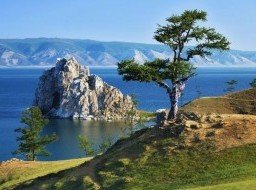Guided winter tour to Siberia. Siberia can only be understood in wintertime with its harsh climate. We are offering this 12-days adventure tour from Moscow to the heart of Siberia and lake Baikal to give you the opportunity to experience those real cold and special winter days.
Your journey will take you to places rarely visited by tourists and give you an authentic glimpse into the everyday life in Siberia. One of the highlights will be the crossing of the frozen lake by foot or by car (depending on weather conditions). The lake is frozen in February and March only. In the winter months when the lake is icy but not yet frozen, you will enjoy a day hike through the wintery forests along the shore of lake Baikal instead.
In Moscow you are going to experience the rich cultural life of the Russian metropole embedded in beautiful winter scenery. After two days of visits to known and unknown places in Moscow, you will depart on your train journey towards Novosibirsk, your first stop along the Trans-Siberian railroad. The construction of the world’s longest and most difficult to build railway, the Trans-Siberian railroad, was finished over a 100 years ago. The link between Moscow and Vladivostok, some 6000 miles apart, was completed employing a labour force of over 90000. Ever since the rail service linking Europe with the Far East was established at the turn of last century, foreign travellers and adventurers have been fascinated by this great journey and crossed Siberia to reach the Pacific or China. Across the Ural mountains to Siberia, through towns that were built along the rails into the Mongolian steps and Gobi desert, the Trans-Siberian journey offers a great opportunity to experience an unforgettable trip. You will spend a total of five days on the train past the Ural Mountains through white forests, along frozen lakes and rivers, and through remote villages of painted wooden houses. Irkutsk, the final destination, is also called ‘Paris’ of Siberia for its pulsing street life and people’s elegant clothes. Still a major trade center for furs, Irkutsk enjoys today a certain economic wealth. Short but hot summers and very cold winters, however, make life here a real challenge. If the weather permits, you will cross parts of the frozen lake on foot for a 20 km walk until the village of Bolshie Koty, where you can take a real Russian steam bath on the shore of the lake (optional, not included) and sleep in a warm comfortable Siberian wooden house. Those brave enough can even take a short swim under the ice. Bizarre formations of ice arise from the high pressure of the thick plate of ice moving against the shore. The noise of the crushing ice at night will last as an unforgettable memory.
Details on lake Baikal:
Irkutsk can be as cold as -20°C at night in winter. Thermal protection is essential, especially for feet, fingers and face. Also, UV protecting sunglasses are required for eye protection. The crossing of the lake and the overnight stay on the lake are absolutely safe. The ice of the lake is min. 1m thick and can hold a car or even a large lorry easily. Polar sleeping bags and equipment to sleep in tents on the lake will be provided.
A few data:
- Thickness of the ice in March: 100-110 cm
- Average daily temperature in March + 10-15°C
- Average temperature at night: -15°C
In Moscow you are going to experience the rich cultural life of the Russian metropole embedded in beautiful winter scenery. After two days of visits to known and unknown places in Moscow, you will depart on your train journey towards Novosibirsk, your first stop along the Trans-Siberian railroad. The construction of the world’s longest and most difficult to build railway, the Trans-Siberian railroad, was finished over a 100 years ago. The link between Moscow and Vladivostok, some 6000 miles apart, was completed employing a labour force of over 90000. Ever since the rail service linking Europe with the Far East was established at the turn of last century, foreign travellers and adventurers have been fascinated by this great journey and crossed Siberia to reach the Pacific or China. Across the Ural mountains to Siberia, through towns that were built along the rails into the Mongolian steps and Gobi desert, the Trans-Siberian journey offers a great opportunity to experience an unforgettable trip. You will spend a total of five days on the train past the Ural Mountains through white forests, along frozen lakes and rivers, and through remote villages of painted wooden houses. Irkutsk, the final destination, is also called ‘Paris’ of Siberia for its pulsing street life and people’s elegant clothes. Still a major trade center for furs, Irkutsk enjoys today a certain economic wealth. Short but hot summers and very cold winters, however, make life here a real challenge. If the weather permits, you will cross parts of the frozen lake on foot for a 20 km walk until the village of Bolshie Koty, where you can take a real Russian steam bath on the shore of the lake (optional, not included) and sleep in a warm comfortable Siberian wooden house. Those brave enough can even take a short swim under the ice. Bizarre formations of ice arise from the high pressure of the thick plate of ice moving against the shore. The noise of the crushing ice at night will last as an unforgettable memory.In Moscow you are going to experience the rich cultural life of the Russian metropole embedded in beautiful winter scenery. After two days of visits to known and unknown places in Moscow, you will depart on your train journey towards Novosibirsk, your first stop along the Trans-Siberian railroad. The construction of the world’s longest and most difficult to build railway, the Trans-Siberian railroad, was finished over a 100 years ago. The link between Moscow and Vladivostok, some 6000 miles apart, was completed employing a labour force of over 90000. Ever since the rail service linking Europe with the Far East was established at the turn of last century, foreign travellers and adventurers have been fascinated by this great journey and crossed Siberia to reach the Pacific or China. Across the Ural mountains to Siberia, through towns that were built along the rails into the Mongolian steps and Gobi desert, the Trans-Siberian journey offers a great opportunity to experience an unforgettable trip. You will spend a total of five days on the train past the Ural Mountains through white forests, along frozen lakes and rivers, and through remote villages of painted wooden houses. Irkutsk, the final destination, is also called ‘Paris’ of Siberia for its pulsing street life and people’s elegant clothes. Still a major trade center for furs, Irkutsk enjoys today a certain economic wealth. Short but hot summers and very cold winters, however, make life here a real challenge. If the weather permits, you will cross parts of the frozen lake on foot for a 20 km walk until the village of Bolshie Koty, where you can take a real Russian steam bath on the shore of the lake (optional, not included) and sleep in a warm comfortable Siberian wooden house. Those brave enough can even take a short swim under the ice. Bizarre formations of ice arise from the high pressure of the thick plate of ice moving against the shore. The noise of the crushing ice at night will last as an unforgettable memory.In Moscow you are going to experience the rich cultural life of the Russian metropole embedded in beautiful winter scenery. After two days of visits to known and unknown places in Moscow, you will depart on your train journey towards Novosibirsk, your first stop along the Trans-Siberian railroad. The construction of the world’s longest and most difficult to build railway, the Trans-Siberian railroad, was finished over a 100 years ago. The link between Moscow and Vladivostok, some 6000 miles apart, was completed employing a labour force of over 90000. Ever since the rail service linking Europe with the Far East was established at the turn of last century, foreign travellers and adventurers have been fascinated by this great journey and crossed Siberia to reach the Pacific or China. Across the Ural mountains to Siberia, through towns that were built along the rails into the Mongolian steps and Gobi desert, the Trans-Siberian journey offers a great opportunity to experience an unforgettable trip. You will spend a total of five days on the train past the Ural Mountains through white forests, along frozen lakes and rivers, and through remote villages of painted wooden houses. Irkutsk, the final destination, is also called ‘Paris’ of Siberia for its pulsing street life and people’s elegant clothes. Still a major trade center for furs, Irkutsk enjoys today a certain economic wealth. Short but hot summers and very cold winters, however, make life here a real challenge. If the weather permits, you will cross parts of the frozen lake on foot for a 20 km walk until the village of Bolshie Koty, where you can take a real Russian steam bath on the shore of the lake (optional, not included) and sleep in a warm comfortable Siberian wooden house. Those brave enough can even take a short swim under the ice. Bizarre formations of ice arise from the high pressure of the thick plate of ice moving against the shore. The noise of the crushing ice at night will last as an unforgettable memory.v


































